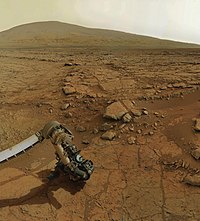
 |
| This article is one of a series on: |
| Life in the universe |
|---|
| Outline |
| Planetary habitability in the Solar System |
| Life outside the Solar System |
| Habitability of... |
Whether there is life on Titan, the largest moon of Saturn, is currently an open question and a topic of scientific assessment and research. Titan is far colder than Earth, but of all the places in the Solar System, Titan is the only place besides Earth known to have liquids in the form of rivers, lakes, and seas on its surface. Its thick atmosphere is chemically active and rich in carbon compounds. On the surface there are small and large bodies of both liquid methane and ethane, and it is likely that there is a layer of liquid water under its ice shell. Some scientists speculate that these liquid mixes may provide prebiotic chemistry for living cells different from those on Earth.
In June 2010, scientists analyzing data from the Cassini–Huygens mission reported anomalies in the atmosphere near the surface which could be consistent with the presence of methane-producing organisms, but may alternatively be due to non-living chemical or meteorological processes.[1] The Cassini–Huygens mission was not equipped to look directly for micro-organisms or to provide a thorough inventory of complex organic compounds.